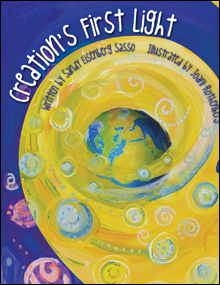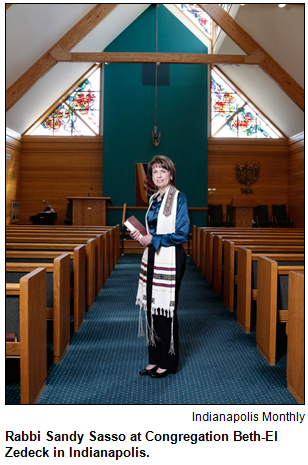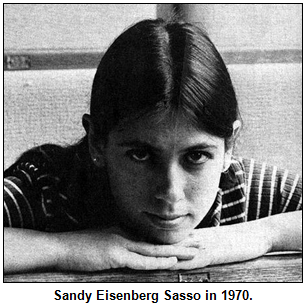Oct. 19 show
Rabbi Sandy Sasso, pioneer for women clergy
 Nearly 40 years ago, she was ordained as the country's first woman rabbi from the Jewish Reconstructionist movement. When Sandy Eisenberg Sasso and her husband, Dennis Sasso, were hired at Congregation Beth-El Zedeck in Indianapolis in 1977, they also became the world's first husband-and-wife rabbi team to serve a congregation jointly.
Nearly 40 years ago, she was ordained as the country's first woman rabbi from the Jewish Reconstructionist movement. When Sandy Eisenberg Sasso and her husband, Dennis Sasso, were hired at Congregation Beth-El Zedeck in Indianapolis in 1977, they also became the world's first husband-and-wife rabbi team to serve a congregation jointly.
Earlier this year, Sandy Sasso retired as senior rabbi at the synagogue, but her career continues as an author of best-selling books for children, a civic leader and a speaker known for her storytelling gifts.
She also has become the director of a new program, the Religion, Spirituality and Arts Initiative under the auspices of the Butler University Center for Faith and Vocation.
 When Sandy became a rabbi in 1974, only one other American woman, from a different Jewish movement, had been ordained.
When Sandy became a rabbi in 1974, only one other American woman, from a different Jewish movement, had been ordained.
Her children's books - beginning with God's Paintbrush (Jewish Lights Publishing) in 1994 - are sold around the world and have been translated into German, Italian, Spanish, Hebrew and other languages. She says she became an author after she could not find faith-oriented books for her son and daughter when they were children.
Now a grandmother, Sandy Sasso will join Nelson in studio for a show about her trailblazing career and multifaceted life as one of the best-known women in central Indiana.
"I read of men's struggles with God, but not women's," Sandy is quoted as saying in 19 Stars of Indiana: Exceptional Hoosier Women (IU Press, 2009), a book of profiles by Michael S. Maurer. "No one was answering my questions. In fact, no one was asking them."
She was referring to her growing interest in becoming a rabbi during her youth in Philadelphia, her home town.  Sandy and Dennis Sasso were both just 31 years old when they were chosen to lead Beth-El Zedeck, 600 W. 70th St., and made history.
Sandy and Dennis Sasso were both just 31 years old when they were chosen to lead Beth-El Zedeck, 600 W. 70th St., and made history.
Sandy went on to earn a doctorate from Christian Theological Seminary and has received honorary doctorates from several Indiana colleges.
Since her ordination, women rabbis are no longer unusual. A total of more than 700 women across the country currently serve as rabbis from the various streams of Judaism, according to an article in The Indianapolis Star when Sandy retired at Beth-El Zedeck. (In Orthodox Judaism, women are not ordained.)
Her newest book, Creation's First Light, has just been published. An illustrated description of the Earth's creation that's inspired by the biblical chapter of Genesis, Creation's First Light been called "a perfect jewel of a book" by another distinguished Hoosier History Live! guest who also is an ordained member of the clergy: Quaker pastor and author Phil Gulley. (Known for his folksy stories about a fictional town that resembles his hometown of Danville, Phil was Nelson's guest for a show last May.)
Her other books for children - many of which cover religious issues in a non-denominational way - include God Said Amen, For Heaven's Sake, Noah's Wife and In God's Name, which invites young readers to come up with their own names for God based on what they value most. Sandy's adult books include Midrash: Reading the Bible with Question Marks.
 She met her husband, Dennis, who was born in Panama, when they were seminary students. Neither of the Sassos knew much about Indy when they moved to the Hoosier capital for what turned into 36 years of serving together at Beth-El Zedeck.
She met her husband, Dennis, who was born in Panama, when they were seminary students. Neither of the Sassos knew much about Indy when they moved to the Hoosier capital for what turned into 36 years of serving together at Beth-El Zedeck.
"I have come to care deeply about the future of Indianapolis, its problems, and its vision for overcoming them," Sandy wrote earlier this year in an account for Indianapolis Monthly magazine. "There are matters that require attention: hunger, healthcare, transportation, education, caring for those who are marginalized. But there are also people who are trying to create change, who fashion venues for civil conversation, who believe that diversity enriches us, that culture is good for the soul and for business."
Her civic endeavors include serving for three years as the board chair for the Spirit & Place Festival, the annual collaboration in November that celebrates the arts, culture and spirituality.
History nugget: In 2002, Sandy was the editor of Urban Tapestry: Indianapolis Stories (IU Press), a collection of insights and essays about the Hoosier capital. Contributing writers included our host, Nelson.
Learn more: Sandy Sasso has just launched a new website, www.allaboutand.com.
Roadtrip: Duckpin bowling in Fountain Square
 Guest Roadtripper Gary BraVard suggests we take the Roadtrip to play a little duckpin bowling (like regular bowling but everything is smaller!) in the Fountain Square Theatre Building. That's at the intersection of Virginia Avenue at Shelby and Prospect Streets just southeast of downtown Indianapolis.
Guest Roadtripper Gary BraVard suggests we take the Roadtrip to play a little duckpin bowling (like regular bowling but everything is smaller!) in the Fountain Square Theatre Building. That's at the intersection of Virginia Avenue at Shelby and Prospect Streets just southeast of downtown Indianapolis.
And yes, Fountain Square has its original 1880 fountain, "Lady Spray," back squarely in the square! The statue "Pilgrim Family," which had occupied the square for some time, was moved just across the street.
Fountain Square continues to grow as a vibrant and eclectic neighborhood; it grew up around the end of the old Virginia Avenue streetcar line.
But Roadtripper Gary suggests you try a little duckpin bowling at the Fountain Square Theatre Building. The building sports two bowling facilities, Action Duckpin Bowl on the fourth floor and Atomic Bowl Duckpin in the basement.
Building owner Linton Calvert said he started collecting pieces of old duckpin bowling facilities some 20 years ago, all across the country. He says that most of the pieces from the Action Duckpin Bowl on the fourth floor were harvested from a defunct facility in Columbia City, Ind. Tune in Saturday for more!
History Mystery
Amid controversy in 1977, an Indianapolis resident became the first woman ever ordained as a priest in the Episcopal Church. Her ordination on New Year's Day at All Saints Episcopal Church in the Old Northside neighborhood drew national attention, including opposition from other Episcopal priests. Before her ordination, the trail-blazing priest had worked as a licensed practical nurse and as a prison chaplain.
 Question: Name the Episcopalian priest whose ordination made headlines in 1977.
Question: Name the Episcopalian priest whose ordination made headlines in 1977.
The call-in number is (317) 788-3314. Please do not call into the show until you hear Nelson pose the question on the air, and please do not try to win the prize if you have won any other prize on WICR during the last two months.
The prize is admission for four to the Indiana Experience at the Indiana History Center, a gift certificate to Le Peep Restaurants, and two passes to the Crown Hill Cemetery public tours, courtesy of Visit Indy.
Last week's answer
By request, we are publishing the answer to last week's History Mystery, in case you didn't catch it on the air. The Oct. 12 History Mystery answer is: GEORGE McGINNIS.
In 1969, many sports analysts considered him the best high school athlete in the country because of his basketball exploits at Washington High School. He propelled the team to an unbeaten season, then drew headlines with a 35-point scoring "eruption" during the state championship game at Hinkle Fieldhouse.
After leading the Big Ten in scoring at Indiana University, McGinnis - who, at six-feet-eight, became known as "Big Mac" - thrilled fans of the Indiana Pacers. He played for the Pacers for four seasons (1972-75), before leaving to play for teams such as the Philadelphia 76ers, then returned to the Pacers in 1979.
Since retiring as a player three years later, George McGinnis has remained in the public eye as an Indianapolis-based business executive and, for many years, a TV and radio sportscaster.
Your Hoosier History Live! team,
Nelson Price, host and creative director
Molly Head, producer, (317) 927-9101
Richard Sullivan, webmaster and tech director
Pam Fraizer, graphic designer
Garry Chilluffo, creative consultant
Michele Goodrich, Jed Duvall, grant consultants
Joan Hostetler, photo historian
Dana Waddell, volunteer-at-large
www.hoosierhistorylive.org






Please tell our sponsors that you appreciate their support: Indiana Authors Award | Indiana Historical Society | Lucas Oil | Re/Max Metro | Story Inn | The Fountain Square Theatre Building

 Acknowledgments to Print Resources, Monomedia, Indiana Humanities, Visit Indy, WICR-FM, Fraizer Designs, Heritage Photo & Research Services, Derrick Lowhorn and many other individuals and organizations. We are an independently produced program and are self-supporting through organizational sponsorships, grants and through individual tax-deductible contributions through Indiana Humanities. We do not receive any government funding. Visit our website to learn how you can support us financially. Also, see our Twitter feed and our Facebook page for regular updates.
Acknowledgments to Print Resources, Monomedia, Indiana Humanities, Visit Indy, WICR-FM, Fraizer Designs, Heritage Photo & Research Services, Derrick Lowhorn and many other individuals and organizations. We are an independently produced program and are self-supporting through organizational sponsorships, grants and through individual tax-deductible contributions through Indiana Humanities. We do not receive any government funding. Visit our website to learn how you can support us financially. Also, see our Twitter feed and our Facebook page for regular updates.
Oct. 26 show
Environmental heritage across Indiana
The way history has unfolded, maybe we should call this show "the good, the bad and the ugly."
Early settlers in Indiana and subsequent generations clear-cut the dense, unbroken forest of towering trees that had dominated the Hoosier landscape, resulting in soil erosion and other significant challenges. But, beginning with work during the Great Depression undertaken by the Civilian Conservation Corps, the Hoosier National Forest was recreated extensively in southern Indiana.
 White River in the Indianapolis area has been substantially cleaned up, particularly when contrasted with its previous reputation as a dumping ground and a punch line for jokes. Many experts, though, consider the Grand Calumet River in northwestern Indiana still to be among the top 10 dirtiest in the country.
White River in the Indianapolis area has been substantially cleaned up, particularly when contrasted with its previous reputation as a dumping ground and a punch line for jokes. Many experts, though, consider the Grand Calumet River in northwestern Indiana still to be among the top 10 dirtiest in the country.
New hotels, businesses and buildings on university campuses in Indiana are winning acclaim for their energy-saving features. Concerns are increasing, though, about factory farms and their impact on nearby communities and havens such as Camp Tecumseh, a retreat near Monticello that's been beloved by generations of Hoosier youth.
To explore the state's environmental heritage, Nelson will be joined in studio by two guests from the Hoosier Environmental Council, a non-profit that's celebrating its 30th anniversary.
The HEC, which describes itself as a "science-based advocacy organization dedicated to protecting Indiana's environment," will host one of the state's largest gatherings of environmentalists on Nov. 16 on the campus of Indiana University-Purdue University at Indianapolis.
Nelson's guests will be:
- Jesse Kharbanda, the dynamic former Rhodes Scholar who has been HEC's executive director since 2007. Known for his media savvy - Jesse has been a Nuvo Newsweekly cover subject and a familiar interviewee on TV and radio shows - he has emphasized ways that environmentalists can work in concert with business leaders and religious conservatives rather than being seen as perpetually at, well, loggerheads.
- Tim Maloney, HEC's senior policy director. He also has been the chair of Hoosier chapter of the Sierra Club; during the early 1980s, Tim helped found the HEC as a board member.
"A lot of what we're worried about today results from actions taken decades ago and generations ago," Jesse Kharbanda says, referring to what he and others call "legacy waste."
He also says: "Everyone cares about nature. They just care about different facets of it, in different ways, with different approaches to dealing with problems."
© 2013 Hoosier History Live! All rights reserved.